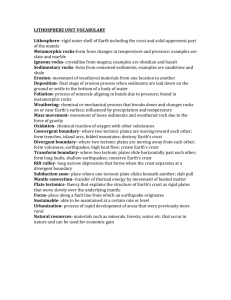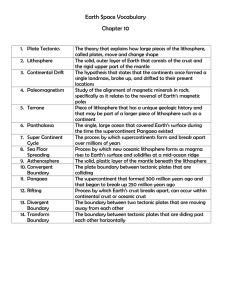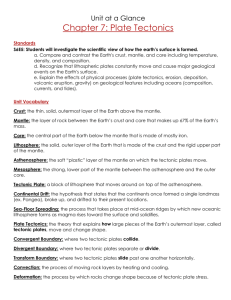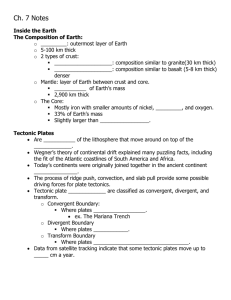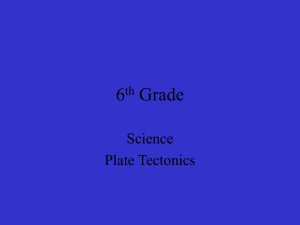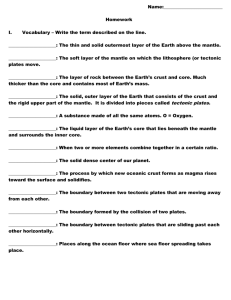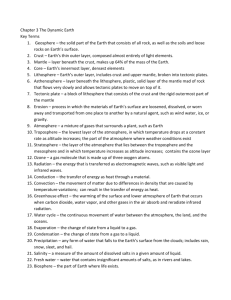Chapter 15 Study Guide: Plate Tectonics
advertisement
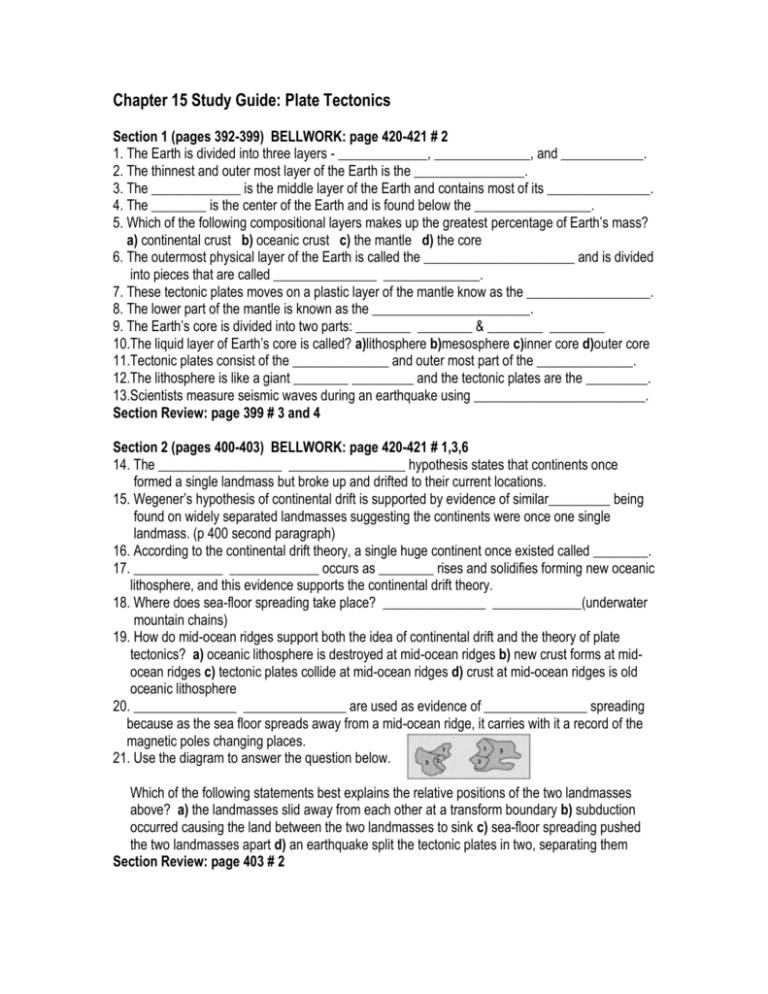
Chapter 15 Study Guide: Plate Tectonics Section 1 (pages 392-399) BELLWORK: page 420-421 # 2 1. The Earth is divided into three layers - _____________, ______________, and ____________. 2. The thinnest and outer most layer of the Earth is the ________________. 3. The _____________ is the middle layer of the Earth and contains most of its _______________. 4. The ________ is the center of the Earth and is found below the _________________. 5. Which of the following compositional layers makes up the greatest percentage of Earth’s mass? a) continental crust b) oceanic crust c) the mantle d) the core 6. The outermost physical layer of the Earth is called the ______________________ and is divided into pieces that are called _______________ ______________. 7. These tectonic plates moves on a plastic layer of the mantle know as the __________________. 8. The lower part of the mantle is known as the _______________________. 9. The Earth’s core is divided into two parts: ________ ________ & ________ ________ 10.The liquid layer of Earth’s core is called? a)lithosphere b)mesosphere c)inner core d)outer core 11.Tectonic plates consist of the ______________ and outer most part of the ______________. 12.The lithosphere is like a giant ________ _________ and the tectonic plates are the _________. 13.Scientists measure seismic waves during an earthquake using _________________________. Section Review: page 399 # 3 and 4 Section 2 (pages 400-403) BELLWORK: page 420-421 # 1,3,6 14. The __________________ _________________ hypothesis states that continents once formed a single landmass but broke up and drifted to their current locations. 15. Wegener’s hypothesis of continental drift is supported by evidence of similar_________ being found on widely separated landmasses suggesting the continents were once one single landmass. (p 400 second paragraph) 16. According to the continental drift theory, a single huge continent once existed called ________. 17. _____________ _____________ occurs as ________ rises and solidifies forming new oceanic lithosphere, and this evidence supports the continental drift theory. 18. Where does sea-floor spreading take place? _______________ _____________(underwater mountain chains) 19. How do mid-ocean ridges support both the idea of continental drift and the theory of plate tectonics? a) oceanic lithosphere is destroyed at mid-ocean ridges b) new crust forms at midocean ridges c) tectonic plates collide at mid-ocean ridges d) crust at mid-ocean ridges is old oceanic lithosphere 20. _______________ _______________ are used as evidence of _______________ spreading because as the sea floor spreads away from a mid-ocean ridge, it carries with it a record of the magnetic poles changing places. 21. Use the diagram to answer the question below. Which of the following statements best explains the relative positions of the two landmasses above? a) the landmasses slid away from each other at a transform boundary b) subduction occurred causing the land between the two landmasses to sink c) sea-floor spreading pushed the two landmasses apart d) an earthquake split the tectonic plates in two, separating them Section Review: page 403 # 2 Section 3 (pages 404-407) BELLWORK: page 420-421 # 4,8,9 22. In the theory of __________ _____________, Earth’s tectonic plates meet at an area called a ________________. 23. What type of boundary is formed when plates collide? a ______________________ boundary 24. Some of the world’s folded mountains formed as a result of a) oceanic-oceanic separation at mid-ocean ridges b)continental-continental separation at rift zones c)continental-oceanic collision at subduction zones d) continental-continental collision at convergent boundaries 25. What type of boundary is formed when plates separate forming new sea floor? _____________ 26. Sea-floor spreading occurs at which of the following types of tectonic plate boundaries? a) transform b) convergent c)divergent d) strike-slip 27. What type of boundary is formed when plates slide past each other? ___________________ 28. The process by which hot rock from deep within Earth rises and cooler rock near the surface sinks is called ______________________. (page 406 Figure 1 #2) 29. Scientists use a ___________ ________________ _____________ to measure the movement of tectonic plates. (page 407) 30. Name the three types of boundaries below : (no section review) 1_____________________ 2_____________________ 3______________________ Section 4 (pages 408-414) BELLWORK: page 420-421 # 5,7,10 31. Stress that squeezes a rock layer is known as ____________________. 32. Stress that stretches a rock layer is know as _______________, and this can lead to mountains with sharp, jagged peaks. 33. The bending of rock layers because of stress in Earth’s crust is called ________________. 34. A ______________ is the surface along which rocks break and slide past each other. 35. Which of the following geological features is formed as a result of tension? a) an anticline b)a syncline c) a normal fault d) reverse fault (p 410 3rd paragraph) 36. In a normal fault, where does the hanging wall move relative to the footwall? a)upward b) downward c) horizontally d) stays the same 37. What type of fault usually occurs because of compression? a) an anticline b)a syncline c) a normal fault d) reverse fault (p 410 4th paragraph) 38. In a reverse fault, where does the hanging wall move relative to the footwall? a)upward b) downward c) horizontally d) stays the same 39. A ________________ __________ forms when rock breaks and moves horizontally. Use the diagram above and page 413 to answer # 40. 40. How were these mountains formed? a) rock layers were squeezed and folded by tectonic forces b) volcanoes formed rock layers that then cooled and subsided c) Rocks pushed past each other at a transform boundary d) tension caused some rock blocks to drop and tilt up 41. ____________ is the raising of a rock layer to higher elevations. 42. ________________ is the sinking of a rock layer to lower elevations. Section Review: page 415 # 3 & 11 (use page 410) Chapter 15: Plate Tectonics ANSWER KEY 1. crust, mantle, core 2. crust 3. mantle, mass 4. core, mantle 5. C 6. lithosphere, tectonic plates 7. asthenosphere 8. mesosphere 9. outer core, inner core 10. D 11. crust, mantle 12. jigsaw puzzle, pieces 13. seismographs 14. continental drift 15. fossils 16. Pangaea 17. Sea-floor spreading, magma 18. mid-ocean ridges 19. B 20. Magnetic reversals, sea-floor 21. C 22. plate tectonics, boundary 23. convergent 24. D 25. divergent 26. C 27. transform 28. convection 29. global positioning system 30. divergent, transform, convergent 31. compression 32. tension 33. folding 34. fault 35. C 36. B 37. D 38. A 39. strike-slip fault 40. D 41. uplift 42. subsidence Chapter 15 Answer Key SECTION REVIEWS p. 399 3. C 4. B p. 403 2. B p. 415 3. D 11. reverse fault BELLWORK 1. 2. 3. 4. 5. 6. 7. 8. 9. 10. B C A D C C D C D B


